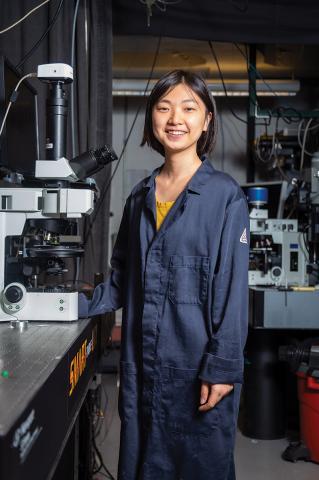A trope of the superhero genre is the training montage. Often it involves an unbelievably deadly obstacle course of some kind or a danger room, the product of the mind of a supergenius mentor, where young heroes hone their skills before venturing out to face real threats. The parallels to graduate school might be tenuous, but anyone who has been through the process will likely find it at least somewhat relatable.
In fact, graduate school is a vital step in the development of young researchers. It gives budding scientists a relatively risk-free environment to explore their interests and develop their skills before venturing out to establish their own labs and research projects. Graduate students in John Badding’s and Elizabeth Elacqua’s groups get the unique opportunity to train in a multidisciplinary setting as part of the Center for Nanothread Chemistry, supported by the Eberly College of Science’s highly collaborative research climate and world-class infrastructure.
“My undergraduate major was applied chemistry and my research was more closely related to organic chemistry,” said Sikai Wu, a doctoral student in Badding’s lab. “I applied to Penn State because of its high ranking in materials science, and was interested in high-pressure chemistry, so I knew right away that I wanted to work with John.”
Wu is focused on trying to better understand the reaction mechanism responsible for the formation of nanothreads. She studies the crystal structure of different precursor materials using X-ray diffraction, observes how it changes under pressure as nanothreads form, and then makes inferences about how the atoms and bonds realign.
“The opportunity to work with so many scientists in the center, which includes researchers at other universities, has been really helpful,” said Wu. “At first it was a little intimidating to be in a meeting with people like Roald Hoffmann, a professor at Cornell who won the Nobel Prize in Chemistry, but I am learning so much.”
Margaret Gerthoffer, a first-year doctoral student in Elacqua’s lab, came from an undergraduate institution where she was able to experience a wide array of research opportunities.
“For graduate school, what was most important to me was to be able to continue working on diverse projects,” said Gerthoffer. “I didn’t want to be stuck doing one thing for the rest of my life and Penn State offered the most opportunities for cross-disciplinary collaborations, by far. When I met Beth, she talked about several collaborative projects that she was working on and it seemed like the perfect blend for me.”
Gerthoffer is focused on developing ways to functionalize nanothreads by identifying different side chains that could replace the hydrogen atoms that currently protrude from the nanothread’s carbon backbone. She is also working to increase nanothread yield and create multifunctional nanothreads using co-crystals of different precursor molecules.
“It’s a bit down the line, but I’ve always been interested in industry,” said Gerthoffer. “I know that I want to be a synthetic chemist—making materials, characterizing them, and finding applications for them—but I won’t limit myself to any particular type of synthesis. Wherever I end up, I know that I will continue to be involved in collaborative research and I’m sure my experience here at Penn State will help me on that path.”
